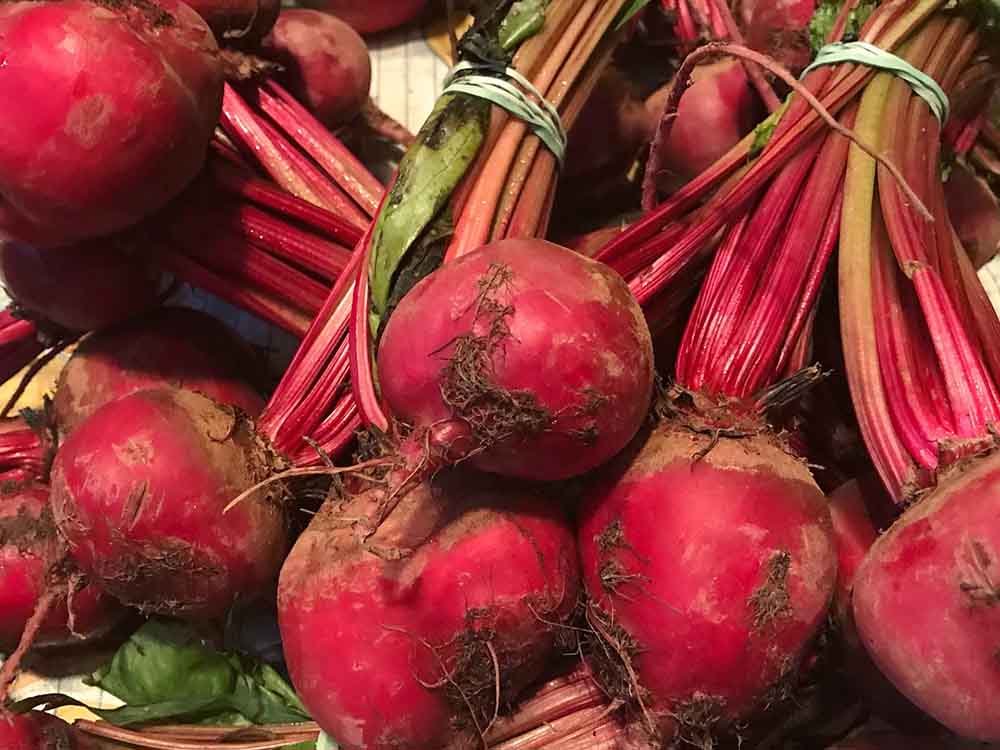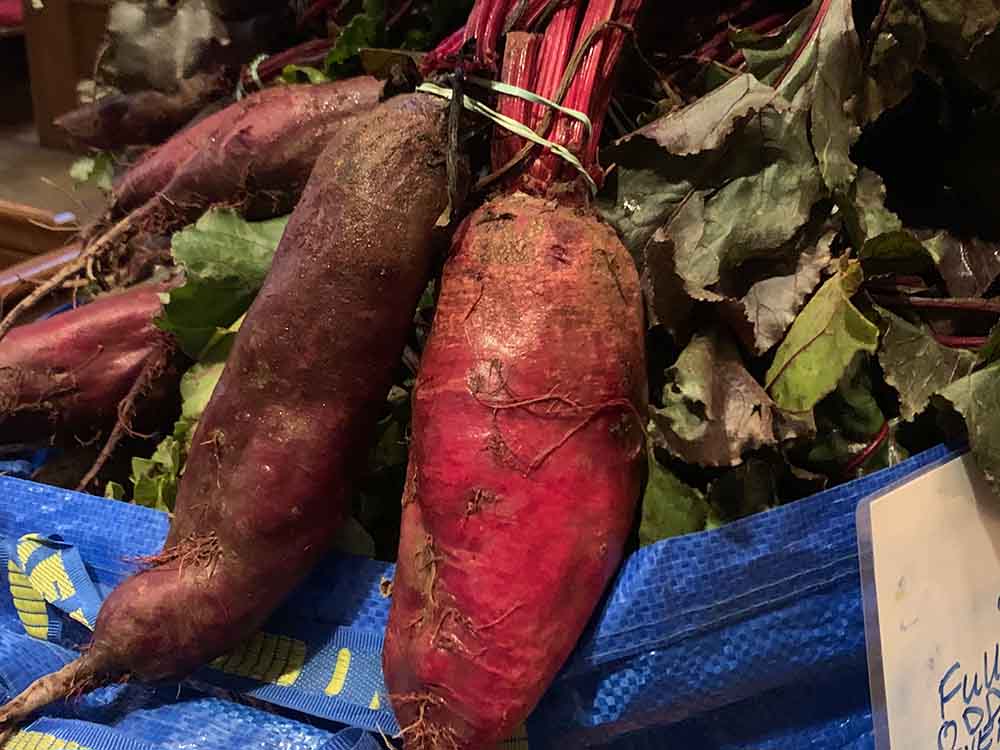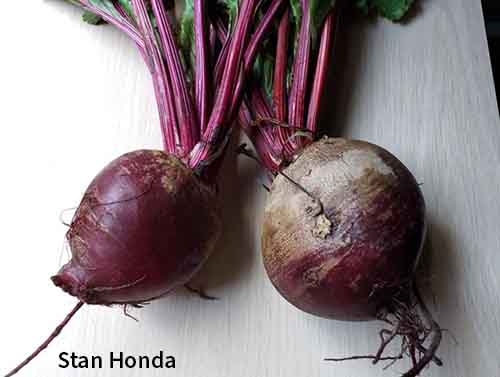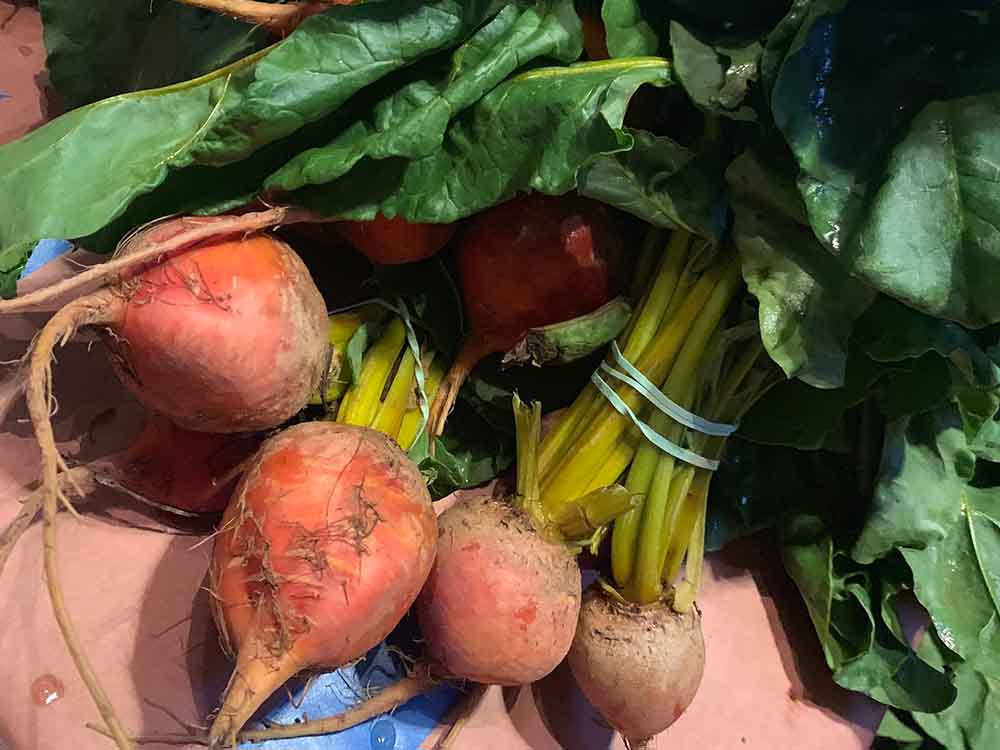BEETS
Beets have a distinct, sweet flavor, add visual pizzaz to any plate, and are packed with antioxidants and other nutrients. So it’s surprising that they are not more popular. At CSA, some members won’t take them—though there are always other members wo grab the leftovers. People often tell us that they never liked beets until they tasted the ones from Stoneledge Farm.
Beets pair well with a variety of foods. They have an affinity for ginger, cinnamon, mint, and other herbs and spices. Cream and cheeses are popular companions—especially feta and goat cheese—as are fruits, especially citrus. Beets are most commonly used in soups, such as borscht, as well as salads and side dishes.
One thing about beets is that they are not easy to prepare. They are heavy and dense, and take a long time to cook. Their thick peel absorbs dirt so it needs to be peeled or scrubbed carefully. And their bright pink juice stains everything it touches (though the stain usually disappears with washing). But beets are worth the trouble!
Varieties in Your Share

Chioggia Beets

Cylindra Beets

Red Ace Beets

Touchstone Gold Beets
Beet roots: Store in a plastic bag in the crisper drawer of your refrigerator. Blot them dry before you put them away. Many sources will tell you that they last about two weeks, but in our experience beets can last a lot longer (although they might begin to lose their flavor after a while).
Beet greens: Separate the roots from the greens when you get home. Remove and compost yellowed or damaged leaves and place the greens in a plastic bags with holes, with a paper towel to absorb extra moisture. Check every few days and discard damaged leaves. Use as soon as possible; they should last up to a week.
Storing cooked beets: Pat dry cooked beets completely before storing. Put them in a container with a tight seal and store in the fridge. Use them within two weeks.
Freezing: You can freeze beets raw, cooked, or roasted, for up to a year. To prepare beets for freezing, remove the greens and scrub the roots with a vegetable brush. You can find a guide to freezing the greens here.
- Raw: Trim and peel the beets, then slice then. Arrange in one layer on a rimmed baking dish, then place, uncovered, in the freezer for about an hour so they don’t clump together. Put them in freezer bags or containers, separating with your fingers if necessary. They will last at least a year.
- Cooked: Trim the beets, then steam/blanch them whole, with the skin on, for 30-60 minutes depending on size. They are done when you can pierce them with a fork. Dunk them in iced water, peel them (the skin should slip off easily at this point), and follow the guidelines for freezing raw beets.
- Roasted: Trim the beets, then put them on a roasting sheet and drizzle with a little olive oil and roast at 350 F for 20-30 minutes, so that they are barely done (enough to be pierced with a fork but no more). Once they are done, the skin should slip off easily, then follow the steps for freezing raw beets.
- You can also freeze cooked foods, like soups and side dishes.
Pickling: Beets can be pickled raw or cooked; it’s a matter of personal taste. No matter which you choose, the process is similar. Peel the beets and cut into slices or chunks, or dice or grate them. Place the beets.
- Refrigerator pickles: Prepare a brine by mixing equal parts water and vinegar such as apple cider or white wine vinegar. Add 1-2 teaspoons salt and 1-2 tablespoons sugar—although you can skip the sugar entirely as beets have plenty of their own. Place the brine in a small pot and boil until the sugar and salt are dissolved. Lower heat and simmer for 5 minutes. Allow to cool and pour over the vegetables, then close the lid. They will last for 4-6 weeks in the refrigerator.
- Canning: To make beets that can be stored outside the refrigerator, carefully follow preserving instructions from a government or university website, such as this one.
Caution: Beets are a low-acid food; if you want to can them, be sure that you have instructions from a reliable institution and follow them carefully.
Trimming: Cut off the greens, leaving 1-2 inches of stem to help prevent bleeding. Save the greens—they are even more nutritious than the beets. Cut off the long root ends, leaving about 1-2 inches, and compost.
Washing: Scrub the beets thoroughly with a vegetable brush to remove dirt and grit.
Peeling: Peeling beets reduces the earthy or ‘dirt’ taste which some people do not like. You can peel raw beets with a sharp vegetable peeler or paring knife. Follow the beet’s contour as you peel, and cut off parts that are gnarled. Or you can cook beets before you peel them. Once cooked, the skins slip off easily—rub the peels off with a towel or your fingers (wear gloves to avoid stains)—or slip a knife under the peel and pull.
Raw: Beets are delicious raw—crunchy and tasty. I wouldn’t serve whole raw beets, but grated, slivered, or spiralized they are excellent additions to salads, salsas, and slaws. They’re too messy for crudités—pink fingers—but thinly sliced raw beets are great in sandwiches and salsas. Grating by hand is very messy; if you can, use a food processor.
Roasting: The easiest way to cook beets is to cut off the tops and bottoms, wrap them loosely in foil—you can wrap them individually; or wrap a bunch together, coat with a little olive oil and salt, add a splash of water, and tent the foil—and roast them on a baking sheet at 375-400 F. If they’re large, halve or quarter them first. They are done when you can poke them with a fork easily, anywhere from 30-90 minutes depending on size and how long they’ve been in storage. I just keep checking them; the only constant I find is that if I’m in a hurry, they take longer. Once they’re soft, the skins peel off easily using your (gloved!) fingers or a paring knife.
Dress with 2 parts olive oil, 1 part rice vinegar, 1 part freshly squeezed lemon juice, salt & pepper; or 2 parts olive oil, 1 part orange juice, garlic, and toasted walnuts.
Steaming: Peel, slice, and arrange in one layer in a steamer basket over boiling water, and steam for 3-4 minutes. Dress simply with a bit of high quality oil and vinegar. This is one of the fastest ways to prepare beets.
Boiling: Put peeled or unpeeled beets in water, heat to boiling, then lower heat and cook until beets are tender, around 30-40 minutes or longer. Drain, remembering that whatever you drain them on will be stained with beet juice. Allow to cool, then peel if you haven’t done so already.
Broiling: Trim the beets and slice them into rounds, then arrange them on a rimmed baking pan, close but not touching. Put them under a broiler for 10-15 minutes, checking frequently until the edges begin to brown.
Soups: Beets are used in many soups, but they are best-known for borscht, which covers a galaxy of recipes. Each Eastern European country has its own version, and there are more local variations in Kyiv, Moscow, and other cities and oblasts. There are green versions made without beets, white versions made with dairy, sour versions and sweet versions, chilled versions for hot summer days, and many made with meat or garnished with potatoes, eggs, cucumbers, or sour cream. We’ve included a few of them here. If you have a favorite or family borscht recipe, please email it to us!
Or add thin slices or small chunks of beets to any soup to add a sweet crunch and a lovely magenta color. They cook quickly in hot soup, so add them in the last 5-10 minutes of cooking.
Grill: Season cooked or uncooked beets with oil, salt, pepper, herbs & spices and arrange on grill.
Stir fry: A great addition to any Asian dishes. Add slivered or diced beets in the last 2-3 minutes of cooking.
Sauté: Slivered or diced over medium-high heat for 3-5 minutes, with a little olive oil and your favorite seasonings. Stoneledge Farm’s Deborah loves them sautéed quickly with a few chopped garlic scapes, mixed with pasta and topped with Parmesan cheese.
Microwaving: Your microwave is a timesaver when it comes to beets, cooking them in a fraction of the time while retaining most of the nutrients. It does require a bit of prep. Trim the beets, and save the greens for later. If the beets are large, cut them into uniform-sized pieces. Wrap them in microwave-safe parchment or put them in a microwave-safe dish covered with plastic wrap, sealing them into little packages with the sides folded under. Microwave on high for about 10-12 minutes per lb. Check the beets carefully—they will be very hot but no longer rock-hard. If they are still very hard, microwave for another minute or two.
Remove, carefully, from the microwave when they are a bit squishy, and let cool until you can unwrap them comfortably. When they are cool enough to handle, slip off the peel with your fingers or with a paring knife.
Beets are by no means easy or quick—I take beet recipes that claim you can finish them in 15 minutes with a grain of salt. But there are some things you can do to make cooking with beets faster and easier.
- Roast or boil all your beets at once: Wait until you have two or more bunches, then choose a cooking method and cook them all. You now have a supply of cooked beets that can be used in salads or any other recipe. They will last up to two weeks in the refrigerator. (See Storing & Preserving above)
- Use your microwave. It’s a true timesaver when it comes to beets. And the beets retain their color, texture, and nutrients. (see Cooking Methods above)
Save the water you use to boil beets. Add some spices—ginger, turmeric, cinnamon—citrus, and sweetener and you’ll have a delicious, super-nutritious drink.
Beet canapés: Slice your cooked, peeled beets into ovals or rounds—or use cookie cutters to slice into more interesting shapes. Pat the beets dry. Cut bread into one-bite servings and spread them with butter, cheese, or cream cheese, then assemble the canapés. Sprinkle with chopped herbs and serve on platters.
Two-ingredient beets: Use cooled, peeled, and sliced beets mixed with just one other ingredient such as preserved lemon or pickled ginger for a super-tasty side dish.
It’s not easy being pink, but you can avoid it:
Cover your surfaces with rescued plastic bags.
Keep a damp rag near you when you’re working with beets; don’t let the stains seep into your cutting board or counter.
Wear gloves!
Wash any stains immediately.
Follow these stain removal tips from Good Housekeeping
RECIPES
DIPS, CHIPS AND DRINKS
SALADS AND SLAWS
MISC
Beets are considered a superfood. They are low in calories (59 calories in a one-cup serving of beet root) and are packed with vitamins and minerals—and the greens are even more nutritious. Beets may also help to improve blood pressure (the nitrates in beets widen blood vessels).
Beet roots are rich in folate—a one-cup serving of raw beets contains 37% of the daily value (DV) of folate—and provide manganese and copper. The nutrient contents stay pretty much the same once cooked.
Beet greens are even lower in calories (just 19 calories in a half-cup serving of boiled beet greens) and are an excellent source of Vitamin K—a half-cup serving of boiled greens contains 348 g of Vitamin K, which is 290% DV—and are rich in Vitamin A (31% DV), Vitamin C (20% DV), and copper (20% DV). The greens are also a good source of manganese, riboflavin, potassium, and magnesium.
Beets are a cool-season vegetable: They tolerate frost and often become sweeter after a hard frost. Small beets can be harvested in the spring, often with tender greens. The fall crop produces larger roots which are sometimes tough. The Kavakoses often wait for a hard frost before they harvest them.
Beets are usually planted from seed. They require full sun (about six hours a day), even moisture, and rock-free soil for best growth.
Beets started out as aquatic plants and have been cultivated for their leaves since prehistoric times in the Middle East. During the Roman era, a genetic deviation led to the ability to grow the species for either their roots or their leaves, and the Beta vulgaris species appeared as both the roots we know today and greens which are now called Swiss chard. Beets and chard are actually subspecies of the same plant. By the age of Charlemagne, people ate beet roots and greens, but it did not become popular until the Renaissance in Europe.
The many types of beets available today are the product of experimentation. In 1747 a German chemist named A. S. Marggraf discovered that sugar could be extracted from beets, and 50 years later, the Napoleonic Wars helped grow the sugar beet industry in Europe. The mangelwurzel, or sugar beet, became fodder for cattle, and beets in all shades of red, purple, white, and gold became popular as well.
The red color of beets is caused by betanin, a compound that does not break down in the body and causes red color in urine and stool (which is perfectly healthy).
That earthy taste is not caused by dirt, but by geosmin, a compound produced by microbes that live in the soil. Geosmin smells very earthy, like rain falling on dry soil, and is present in beets as well as spinach, mushrooms, and lettuce.
https://fdc.nal.usda.gov/fdc-app.html#/food-details/169145/nutrients
https://fdc.nal.usda.gov/fdc-app.html#/food-details/170375/nutrients
https://fdc.nal.usda.gov/fdc-app.html#/food-details/170376/nutrients
https://www.health.harvard.edu/heart-health/a-new-way-to-beet-high-blood-pressure
https://grow.cals.wisc.edu/deprecated/agriculture/five-things-everyone-shoud-know-about-beets
https://en.wikipedia.org/wiki/Sugar_beet
https://www.acs.org/content/acs/en/molecule-of-the-week/archive/g/geosmin.html
CONTRIBUTOR


